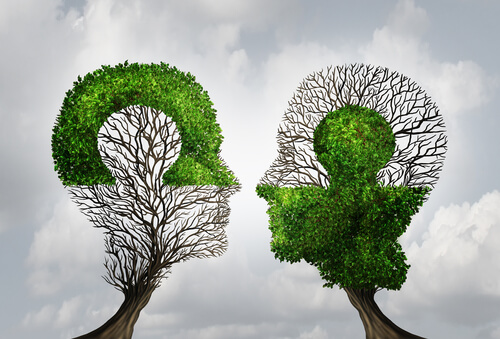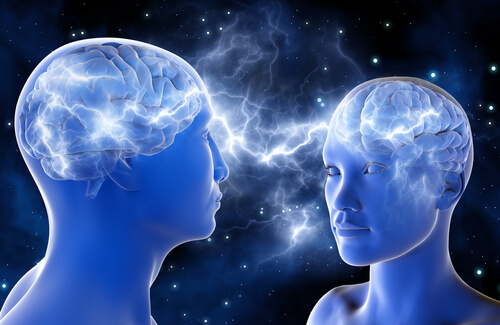Mirror Neurons and Empathy: The Wonder of Connection Mechanisms


Written and verified by the psychologist Valeria Sabater
Mirror neurons and empathy are one of the most fascinating processes in all of neuroscience. These processes allow us to notice the emotions of others and give an empathetic response.
They are mechanisms that also have a social background and using them greatly impacts our daily relationships.
Imagine, for a moment, sitting in a theater. Let’s now see a group of actors performing, executing precise body movements and gestures. Singing each word perfectly and reflecting an endless number of emotions…
“To see with the eyes of another, to hear with the ears of another, to feel with the heart of another.”
-Alfred Adler-
The play wouldn’t make sense if we didn’t have a biological basis for experiencing a range of emotions through empathy. Without it, the “theater” of life would have no significance whatsoever. We would be hollow entities, a civilization of hominids that wouldn’t even have been able to develop language.
Thus, we can’t be surprised that mirror neurons and empathy continues to generate interest in neuroscience, psychology, anthropology, pedagogy, and art.
We’ve worked for decades to understand just a little bit more about our interior architecture, those amazing mechanisms. And we still don’t know everything.

Mirror neurons and empathy, neuroscience’s greatest discoveries
Plenty of scientists and psychologists would state with total certainty that mirror neurons will be for the field of psychology what the discovery of DNA was for biology.
It’s true that knowing more about mirror neurons and empathy helps us know each other a little better. However, we shouldn’t make the mistake of saying that these processes are exclusively what make us human.
What we are today is the result of countless processes all joining forces. Empathy facilitated our social and cultural evolution, but it was not the only determining factor.
Let’s be clear that, when it comes to these areas of neuroscience, there are still some myths to be discarded. It’s not true, for example, that women have more mirror neurons than men. For both genders, about 20% of our neurons are of this type.
“You can only understand people if you feel them in yourself.”
-John Steinbeck-
Also, there are no conclusive studies on the claim that people with autism spectrum disorders have dysfunctional mirror neurons. Nor that they have an absolute lack of empathy.
In fact, the real problem is cognitive, specifically in the “theory of the mind” where one is able to infer information, make a symbolic analysis, and execute a behavior consistent with the stimulus.
To understand these processes a little better, let’s look at more information about what science has told us about mirror neurons and empathy.

Our movements and the relationship to mirror neurons and empathy
This data is not well known and it’s important we keep this in mind. Empathy would not exist without movement, without our actions, gestures, postures.
Contrary to what we may think, mirror neurons are not a specific type of neurons. Actually, they are cells of the pyramid system related to movement.
However, they are unique because they are activated not only with our own movement, but when we observe that of others.
This is what was discovered by Dr. Giacomo Rizzolatti, an Italian neurophysiologist, and professor at the University of Parma. In the 1990’s, he was investigating the motor movements of apes.
He found it fascinating to see how there was a series of neuronal structures that reacted to what another member of the same or another species was doing.
This network of pyramidal neurons or mirror neurons is located in the lower frontal gyrus and in the inferior parietal cortex. It’s found in many species, not just humans. Also, apes and pets, such as dogs and cats, can “empathize” with each other and with us.
Mirror neurons and their relation to our evolution
We pointed out a moment ago that mirror neurons and empathy are not a magic switch that at one moment illuminated our consciousness to allow us to evolve.
Actually, it was a succession of infinite wonders, like hand-eye coordination developing our symbolic consciousness. It was also the qualitative leap in the structures of our neck and skull that made articulated language possible.
Among all these amazing processes are those carried out by the mirror neurons. They happen in our ability to understand and interpret certain gestures. To associate them with a set of meanings and words. In this way, they facilitated social cohesion of the group.

Empathy, an essential cognitive process for relationships
Mirror neurons allow us to empathize with those who surround us. They are the bridge that connects us and links us together. That, in turn, allows us to experience three very basic processes:
- Being able to know and understand what the person in front of us feels or experiences (cognitive component).
- “Feeling” what that person feels (emotional component).
- Finally, here’s a response that definitely requires greater sophistication and sensitivity. We can respond compassionately. This shapes the social behaviors we need to move forward in a group.
On the other hand, there’s an interesting idea proposed by a psychologist at Yale University, Paul Bloom. Many of his articles are controversial, as they suggest that empathy currently does not serve us at all. Behind this striking statement hides an obvious reality.
We have reached a point where we are all able to feel, see, and perceive what others feel. Even on TV. However, we have become so accustomed to it that we remain impassive.
We have normalized the suffering of others. We are so immersed in our own little worlds that we don’t break out of our bubble. Therefore, Professor Singer urges us to be “effective and active altruists.”
Mirror neurons and empathy make up the standard programming of our brains.. It’s like an operating system for a computer. It comes with the computer, but we must learn how to use it effectively, taking full advantage of its potential.

Mirror neurons and empathy: how do we practically apply all this?
Therefore we must learn to look at others and leave our prejudices behind. And actually, limiting ourselves to just “feeling what others are feeling” isn’t the goal.
We have to grasp their reality while maintaining our own. That’s how we can effectively help and support them.
After all, feeling unaccompanied by action is useless. So if we as a species have gotten to this point, it’s precisely because we have been proactive. Because we have taken care of each member of our social group by understanding that we advance more as a group than in solitude.
Recall, therefore, the true purpose of mirror neurons and empathy: to encourage our sociability, our substance, and our connection with the environment.
Mirror neurons and empathy are one of the most fascinating processes in all of neuroscience. These processes allow us to notice the emotions of others and give an empathetic response.
They are mechanisms that also have a social background and using them greatly impacts our daily relationships.
Imagine, for a moment, sitting in a theater. Let’s now see a group of actors performing, executing precise body movements and gestures. Singing each word perfectly and reflecting an endless number of emotions…
“To see with the eyes of another, to hear with the ears of another, to feel with the heart of another.”
-Alfred Adler-
The play wouldn’t make sense if we didn’t have a biological basis for experiencing a range of emotions through empathy. Without it, the “theater” of life would have no significance whatsoever. We would be hollow entities, a civilization of hominids that wouldn’t even have been able to develop language.
Thus, we can’t be surprised that mirror neurons and empathy continues to generate interest in neuroscience, psychology, anthropology, pedagogy, and art.
We’ve worked for decades to understand just a little bit more about our interior architecture, those amazing mechanisms. And we still don’t know everything.

Mirror neurons and empathy, neuroscience’s greatest discoveries
Plenty of scientists and psychologists would state with total certainty that mirror neurons will be for the field of psychology what the discovery of DNA was for biology.
It’s true that knowing more about mirror neurons and empathy helps us know each other a little better. However, we shouldn’t make the mistake of saying that these processes are exclusively what make us human.
What we are today is the result of countless processes all joining forces. Empathy facilitated our social and cultural evolution, but it was not the only determining factor.
Let’s be clear that, when it comes to these areas of neuroscience, there are still some myths to be discarded. It’s not true, for example, that women have more mirror neurons than men. For both genders, about 20% of our neurons are of this type.
“You can only understand people if you feel them in yourself.”
-John Steinbeck-
Also, there are no conclusive studies on the claim that people with autism spectrum disorders have dysfunctional mirror neurons. Nor that they have an absolute lack of empathy.
In fact, the real problem is cognitive, specifically in the “theory of the mind” where one is able to infer information, make a symbolic analysis, and execute a behavior consistent with the stimulus.
To understand these processes a little better, let’s look at more information about what science has told us about mirror neurons and empathy.

Our movements and the relationship to mirror neurons and empathy
This data is not well known and it’s important we keep this in mind. Empathy would not exist without movement, without our actions, gestures, postures.
Contrary to what we may think, mirror neurons are not a specific type of neurons. Actually, they are cells of the pyramid system related to movement.
However, they are unique because they are activated not only with our own movement, but when we observe that of others.
This is what was discovered by Dr. Giacomo Rizzolatti, an Italian neurophysiologist, and professor at the University of Parma. In the 1990’s, he was investigating the motor movements of apes.
He found it fascinating to see how there was a series of neuronal structures that reacted to what another member of the same or another species was doing.
This network of pyramidal neurons or mirror neurons is located in the lower frontal gyrus and in the inferior parietal cortex. It’s found in many species, not just humans. Also, apes and pets, such as dogs and cats, can “empathize” with each other and with us.
Mirror neurons and their relation to our evolution
We pointed out a moment ago that mirror neurons and empathy are not a magic switch that at one moment illuminated our consciousness to allow us to evolve.
Actually, it was a succession of infinite wonders, like hand-eye coordination developing our symbolic consciousness. It was also the qualitative leap in the structures of our neck and skull that made articulated language possible.
Among all these amazing processes are those carried out by the mirror neurons. They happen in our ability to understand and interpret certain gestures. To associate them with a set of meanings and words. In this way, they facilitated social cohesion of the group.

Empathy, an essential cognitive process for relationships
Mirror neurons allow us to empathize with those who surround us. They are the bridge that connects us and links us together. That, in turn, allows us to experience three very basic processes:
- Being able to know and understand what the person in front of us feels or experiences (cognitive component).
- “Feeling” what that person feels (emotional component).
- Finally, here’s a response that definitely requires greater sophistication and sensitivity. We can respond compassionately. This shapes the social behaviors we need to move forward in a group.
On the other hand, there’s an interesting idea proposed by a psychologist at Yale University, Paul Bloom. Many of his articles are controversial, as they suggest that empathy currently does not serve us at all. Behind this striking statement hides an obvious reality.
We have reached a point where we are all able to feel, see, and perceive what others feel. Even on TV. However, we have become so accustomed to it that we remain impassive.
We have normalized the suffering of others. We are so immersed in our own little worlds that we don’t break out of our bubble. Therefore, Professor Singer urges us to be “effective and active altruists.”
Mirror neurons and empathy make up the standard programming of our brains.. It’s like an operating system for a computer. It comes with the computer, but we must learn how to use it effectively, taking full advantage of its potential.

Mirror neurons and empathy: how do we practically apply all this?
Therefore we must learn to look at others and leave our prejudices behind. And actually, limiting ourselves to just “feeling what others are feeling” isn’t the goal.
We have to grasp their reality while maintaining our own. That’s how we can effectively help and support them.
After all, feeling unaccompanied by action is useless. So if we as a species have gotten to this point, it’s precisely because we have been proactive. Because we have taken care of each member of our social group by understanding that we advance more as a group than in solitude.
Recall, therefore, the true purpose of mirror neurons and empathy: to encourage our sociability, our substance, and our connection with the environment.
This text is provided for informational purposes only and does not replace consultation with a professional. If in doubt, consult your specialist.







